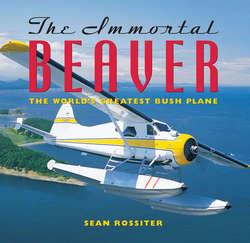Читать книгу The Immortal Beaver - Sean Rossiter - Страница 10
На сайте Литреса книга снята с продажи.
Chapter Five Fred Buller joins DHC
ОглавлениеFacing page: Fred Buller, the renaissance man who devised the systems that made the Beaver a reliable bush plane, is the only individual in this group not smiling. Left to right. Bill Kelley, who worked at DHC with Buller through to the Dash-7 project: Dick Guthrie, who went on to Pratt & Whitney Canada for the PT-6 turbine project; Butler; Jack Greeniaus; and Jim Houston, powerplant engineer. DHC
So Phil Garratt was banished to a grand seclusion on the top flour of what was then the tallest building in the British Empire, Toronto’s Bank of Commerce building, with his long-term secretary, Ann O’Neil.1 It did not seem that way at the time, hut his eviction from DHC was in retrospect the best thing that could have happened to him and to the company. The exile was nor total: he was able to stay in touch with key people at DHC but he wasn’t running the operation any more. Instead, he became the company’s strategic planner.
The penultimate indignity for P.C., as most people called him, was that us a preliminary to cleaning out his desk he was called Upon to sign ones first labour union contract. Three days later he vacated his office. The government and the unions had taken over his near-singlehanded creation. Hatfield backed him up, making him a director of the English company, and making sure, with the office suite that towered high over Toronto’s waterfront, that he would be physically comfortable, it no more than that.
As painful as Garratt’s exile on King Street must have been for the big-hearted chap who revelled in handing out turkeys on the assembly line at Christmas, this was the fallow period during which the only complete line of STOL aircraft in the world was conceived. Phil Garratt didn’t sulk. He used the time well. From mid-1943 to the end of the war, he put together the outlines of a design and manufacturing plan that would win him Canada’s most prestigious aviation award, the Trans-Canada (McKee) Trophy, twice.
As Garratt envisioned the peacetime program and Jaki Jakimiuk designed modifications for the Mosquitoes now swarming out of Downsview, and as chief engineer Doug Hunter somehow outlasted the series of production bosses hired to supplant him, the perfect idea man drifted seemingly by accident into the DHC engineering department. As random as Fred Buller’s presence in 1943 at the periphery of DHC’s Mosquito program might have seemed, nothing about him was the slightest bit haphazard or casual. He had, in fact, invited the government to assign him to a job where his talents could do the most for the war effort. The government had sent him to DHC’s Central Aircraft subsidiary to break the Mosquito logjam.
Fred Buller was one of those fortunate few who succeed spectacularly in a line of work that is their second choice in life. To make a living at something other than one’s favourite activity is common enough. Most people do it. But only a handful somehow manage to so fully integrate their lives that work feeds on recreation, toil on pleasure, and learning becomes not a task but a lifelong habit—a reflex, like breathing. Fred Buller was one of those. It helped that he had the type of mind that thrives on doing more than one thing at once.
Fred would rather have been designing racing yachts. That was his dream. He once told his wife, Betty, that he had been born fifteen years too early to have had a chance to work in that field. He was born May 25, 1914.2
